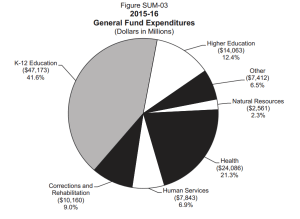Sacramento, CA — Governor Jerry Brown has released a budget that he claims will inject money into schools and health care coverage, and also pay down long term liabilities.
The Governor’s proposed budget is $113-billion for fiscal year 2015-16, compared to $111-billion last year. The information listed below was provided by the Governor’s Office, and lists what Brown feels are the most notable aspects:
Invests in Water, Flood Protection and Combating Climate Change
The Budget includes the first $532 million in expenditures from the Proposition 1 water bond to continue the implementation of the Water Action Plan, the administration’s five-year roadmap towards sustainable water management. Additionally, the Budget includes the last $1.1 billion in spending from the 2006 flood bond to bolster the state’s protection from floods. It also proposes $1 billion in cap-and-trade expenditures for the state’s continuing investments in low-carbon transportation, sustainable communities, energy efficiency, urban forests and high-speed rail. The successful implementation of these projects and continued and even steeper reductions in carbon pollutants are necessary to address the ongoing threat posed by climate change.
Implements Strengthened Rainy Day Fund and Pays Off Debt
Under the Budget, the state’s Rainy Day Fund will have a total balance of $2.8 billion by the end of the year – an insurance policy against future economic downturns. The Budget spends an additional $1.2 billion from Proposition 2 funds on paying off loans from special funds and past liabilities from Proposition 98. In addition, the Budget repays the remaining $1 billion in deferrals to schools and community colleges, makes the last payment on the $15 billion in Economic Recovery Bonds that was borrowed to cover budget deficits from as far back as 2002 and repays local governments $533 million in mandate reimbursements.
Increases K-12 School Spending by $2,600 Per Student Compared to 2011-12
For K-12 schools, funding levels will increase by more than $2,600 per student in 2015-16 over 2011-12 levels. This reinvestment provides the opportunity to correct historical inequities in school district funding with continued implementation of the Local Control Funding Formula. Rising state revenues mean that the state can continue implementing the formula well ahead of schedule. When the formula was adopted in 2013-14, funding was expected to be $47 billion in 2015-16. The Budget provides almost $4 billion more – with the formula instead allocating $50.7 billion this coming year.
Holds Tuition Flat for College Students
University tuition almost doubled during the recession, creating a hardship for many students and their families. The Budget commits $762 million to each of the university systems that is directly attributable to the passage of Proposition 30. This increased funding is provided contingent on tuition remaining flat. All cost containment strategies must be explored before asking California families to pay even more for tuition.
Expands Workforce Training
The Budget provides over $1.2 billion in funding to support a coordinated framework for adult education, career technical education, workforce investment and apprenticeships. These funds are intended to provide training and education to workers in California so they can develop the skills they need for self-sufficiency and greater personal advancement.
Provides Medi-Cal Health Care Coverage to 12.2 Million Californians
Due principally to the implementation of federal health care reform, Medi-Cal caseload has increased from 7.9 million in 2012-13 to an estimated 12.2 million this coming year. The program now covers 32 percent of the state’s population. This tremendous expansion of health care coverage for low-income Californians continues to be an administrative and financial challenge.
Prefunds Retiree Health Care
The state’s unfunded liability for retiree health care benefits is currently estimated at $72 billion. State health care benefits for retired employees remain one of the fastest growing areas of the state budget: in 2001, retiree health benefits made up 0.6 percent of the General Fund budget ($458 million) but today absorb 1.6 percent ($1.9 billion). Without action, the state’s unfunded liability will grow to $100 billion by 2020-21 and $300 billion by 2047-48. The Budget proposes a plan to make these benefits more affordable by adopting various measures to lower the growth in premium costs. The Budget calls for the state and its employees to share equally in the prefunding of retiree health benefits, to be phased in as labor contracts come up for renewal. Under this plan, investment returns will help pay for future benefits, just as with the state’s pension plans, to eventually eliminate the unfunded liability by 2044-45. Over the next 50 years, this approach will save nearly $200 billion.


